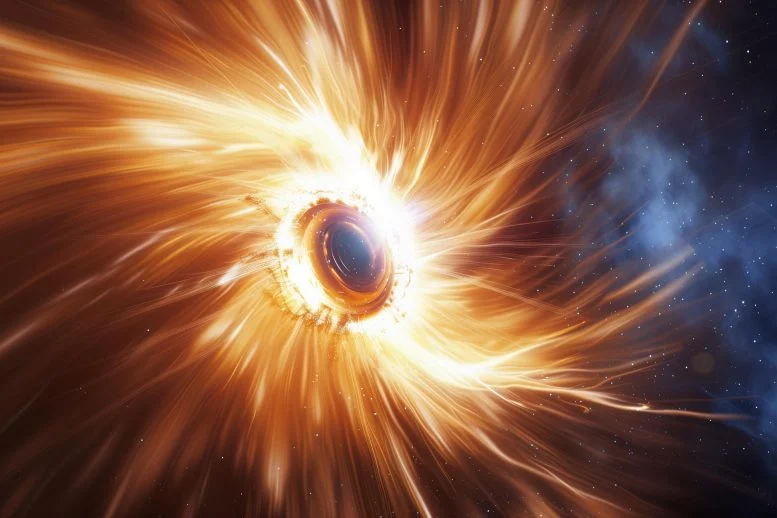
By Royal Astronomical Society December 24, 2024
Collected at: https://scitechdaily.com/the-magnetic-secret-behind-star-formation-uncovered/
Researchers have discovered magnetic fields deep within the merging galaxy Arp 220, suggesting these fields might be crucial for efficient star formation, acting like a cosmic lid that prevents the “boiling over” of star-forming materials.
This breakthrough, observed using the Submillimeter Array in Hawaii, could explain why some galaxies produce stars more effectively than others.
Star Formation Secrets Unveiled
Astronomers have identified a long-sought missing ingredient in the process of star formation, akin to the role a pressure cooker plays in preparing a perfectly steamed Christmas pudding.
Just as the weight on a pressure cooker’s lid locks in pressure to create the ideal environment for cooking, magnetic fields may play a crucial role in merging galaxies, setting the stage for new stars to form.
While this idea had been theorized for years, direct evidence of such magnetic fields had remained elusive — until now.

Groundbreaking Discovery in Galaxy Mergers
Led by Dr. David Clements from Imperial College, an international research team has detected magnetic fields within a dense disc of gas and dust, spanning several hundred light-years, at the core of the merging galaxy system Arp 220.
They say these regions could be the key to making the centers of interacting galaxies just right for cooking lots of hydrogen gas into young stars. This is because magnetic fields may be able to stop intense bursts of star formation in the cores of merging galaxies from effectively ‘boiling over’ when the heat is turned up too high.
A new paper revealing the discovery was published on December 20 in Monthly Notices of the Royal Astronomical Society.

Magnetic Fields: The Cosmic Pressure Cooker
“This is the first time we’ve found evidence of magnetic fields in the core of a merger,” said Dr. Clements, “but this discovery is just a starting point. We now need better models, and to see what’s happening in other galaxy mergers.”
He gave a cooking analogy when explaining the role of magnetic fields in star formation.
“If you want to cook up a lot of stars (Christmas puddings) in a short period of time you need to squeeze lots of gas (or ingredients) together. This is what we see in the cores of mergers. But then, as the heat from young stars (or your cooker) builds, things can boil over, and the gas (or pudding mixture) gets dispersed,” Dr. Clements said.
“To stop this happening, you need to add something to hold it all together – a magnetic field in a galaxy, or the lid and weight of a pressure cooker.”

Unraveling the Mysteries of Star Formation Efficiency
Astronomers have long been looking for the magic ingredient that makes some galaxies form stars more efficiently than is normal.
One of the issues about galaxy mergers is that they can form stars very quickly, in what is known as a starburst. This means they’re behaving differently to other star-forming galaxies in terms of the relationship between star formation rate and the mass of stars in the galaxy – they seem to be turning gas into stars more efficiently than non-starburst galaxies. Astronomers are baffled as to why this happens.
One possibility is that magnetic fields could act as an extra ‘binding force’ that holds the star-forming gas together for longer, resisting the tendency for the gas to expand and dissipate as it is heated by young, hot stars, or by supernovae as massive stars die.
Theoretical models have previously suggested this, but the new observations are the first to show that magnetic fields are present in the case of at least one galaxy.

Future Research and Telescope Advancements
Researchers used the Submillimeter Array (SMA) on Maunakea in Hawaii to probe deep inside the ultraluminous infrared galaxy Arp 220.
The SMA is designed to take images of light in wavelengths of about a millimeter – which lies at the boundary between infrared and radio wavelengths. This opens up a window to a wide range of astronomical phenomena including supermassive black holes and the birth of stars and planets.
Arp 220 is one of the brightest objects in the extragalactic far-infrared sky and is the result of a merger between two gas-rich spiral galaxies, which has triggered starbursting activity in the merger’s nuclear regions.
The extragalactic far-infrared sky is a cosmic background radiation made up of the integrated light from distant galaxies’ dust emissions. About half of all starlight emerges at far-infrared wavelengths.
The next step for the research team will be to use the Atacama Large Millimeter/submillimeter Array (ALMA) – the most powerful telescope for observing molecular gas and dust in the cool universe – to search for magnetic fields in other ultraluminous infrared galaxies.
That is because the next brightest local ultraluminous infrared galaxy to Arp 220 is a factor of four or more fainter.
With their result, and further observations, the researchers hope the role of magnetic fields in some of the most luminous galaxies in the local universe will become much clearer.
Reference: “Polarized dust emission in Arp220: magnetic fields in the core of an ultraluminous infrared Galaxy” by D L Clements, Qizhou Zhang, K Pattle, G Petitpas, Y Ding and J Cairns, 20 December 2024, Monthly Notices of the Royal Astronomical Society: Letters.
DOI: 10.1093/mnrasl/slae107

Leave a Reply